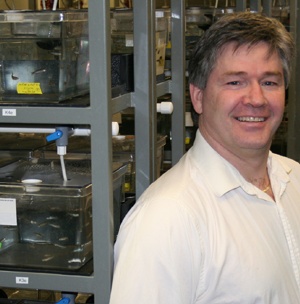Jul 8 2009
Edmonton-University ofAlberta biological sciences professor Gregg Goss is on the front line ofa new effort to monitor the effects of nanomaterials on the environment.
 Greg Goss
Greg Goss
Goss will help lead a team of 19 researchers from across the country in a three-yearstudy of the toxicity of nanomaterials in aquatic environments.
Nanomaterials are the microscopic bits of material that help strengthen productsor make them more efficient. Silver nanoparticles, woven into sweat socks tokill bacteria, are a nanotechonology product on the market right now. But noone knows what effect those silver nanoparticles will have on the water systemwhen they come out in the wash.
"Everything winds up in the water eventually," said Goss.
Goss explains that nanomaterials are very different from mainstream technology."Today, if a company releases a chemical, we can go out there and measureit," said Goss. "But with nanomaterials, once they're released, wecan't measure it."
To get out in front of the analysis of nanomaterials Goss says the researchteam will work with companies as they produce new products. "The problemwith nanomaterials is that classic toxicity tests may not be appropriate,"he said. "We have to figure out what existing tests work, and develop somenew tests."
Goss expects government regulatory agencies will be adjusting their rules asthe nanomaterials industry grows and he sees a role for his research group ascommunicators.
"We'd like to see a co-ordinated response where one set of toxicity testscan be shared by Canada, the United States, Europe and other producing nations."
Goss shares the leadership role in the program with researcher Geoffrey Sunaharaat the National Research Council's biotechnology lab in Montreal. The $3.39million program is funded by the U of A, NRC, Natural Sciences and EngineeringResearch Council of Canada, the National Institute for Nanotechnology and EnvironmentCanada. Private sector companies involved include VIVE Nano, Golder Associatesand HydroQual Laboratories.
Goss says it's difficult to imagine what nanotechnology won't be used for.He uses an old television commercial produced by a multinational chemical companyto describe the future of nanomaterials. "Remember those BSAF ads thatsaid, 'We don't make things. We make things better,'" said Goss. "That'sessentially what nanotechnology is going to do."
Goss predicts many areas of daily life will benefit from nanomaterials, whichincludes more sustainable world travel. "It's going to make stronger steelso commercial aircraft are lighter and fly further on less fuel."
Fortunately Goss believes 99.9 per cent of nanomaterial products will be foundto be completely benign. Finding the downside will be the challenge. "We'reset to identify problem nanomaterials and prevent them from getting out intothe market. That's our job."